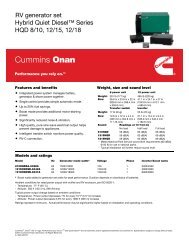Air Brake Manual
Air Brake Manual
Air Brake Manual
You also want an ePaper? Increase the reach of your titles
YUMPU automatically turns print PDFs into web optimized ePapers that Google loves.
Loss of Reservoir <strong>Air</strong> Pressure<br />
28<br />
21<br />
In this illustration the pressure has been lowered to<br />
approximately 45-20 psi and the tractor protection<br />
system has closed automatically, placing the trailer<br />
brakes into an emergency position. Also, the spring<br />
parking brakes system has had the air pressure<br />
released activating the spring parking brakes.<br />
The truck protection system described is an<br />
example of a tractor equipped with a type of cabmounted<br />
trailer supply valve (28) which will close<br />
automatically when the air pressure in the supply<br />
(emergency) line (21) drops below 45-20 psi. The<br />
valve may also be closed manually.<br />
<strong>Manual</strong> Trailer Supply Valve<br />
Some older tractors may be equipped with a different<br />
type of cab-mounted trailer supply valve which must<br />
be operated manually by the driver. It has two<br />
positions: normal and emergency.<br />
The tractor will be equipped with a tractor protection<br />
valve, and the trailer unit with a relay emergency<br />
valve, as in the previous system.<br />
The functions of the trailer supply valve, tractor<br />
protection valve and the relay emergency valve will<br />
be similar to those explained previously. However,<br />
there is one important difference. In the event of<br />
tractor reservoir air loss, the trailer supply valve must<br />
be shifted to the emergency position manually to seal<br />
off the tractor.<br />
Any time the driver shifts the cab-mounted trailer<br />
supply valve to the emergency position, and the<br />
trailer system is charged, the trailer supply valve will<br />
exhaust the supply (emergency) line, which causes<br />
the trailer reservoir to dump its air directly to the<br />
trailer brake chambers.<br />
The trailer brakes will remain applied only as long as<br />
air pressure remains within the trailer system. How<br />
long the air in the system will hold the brakes applied<br />
depends on how airtight the system is. As a safety<br />
precaution, parked trailers without spring parking<br />
brakes should always have the wheels blocked to<br />
prevent a possible runaway. To move a trailer that has<br />
been parked with the brakes in an emergency<br />
application, it is necessary to charge the system to<br />
release the trailer brakes.<br />
51




